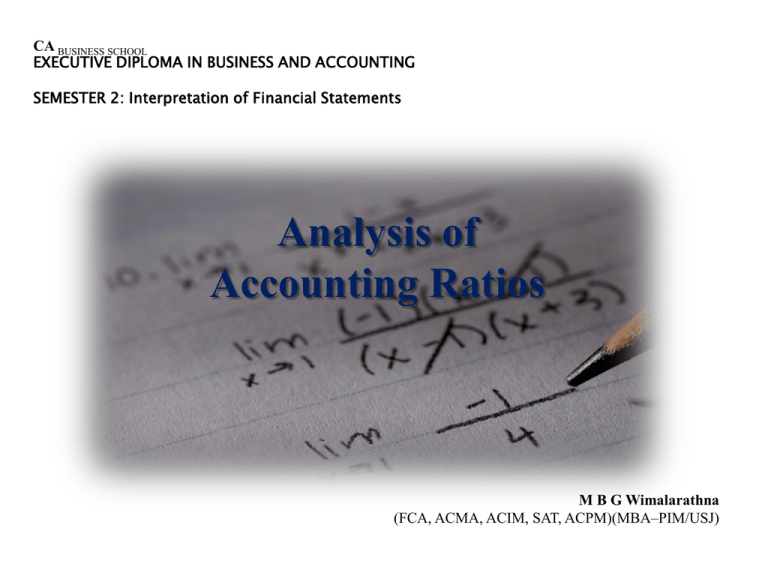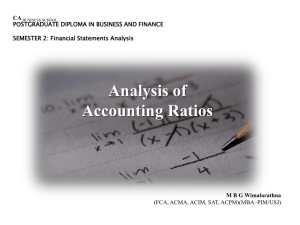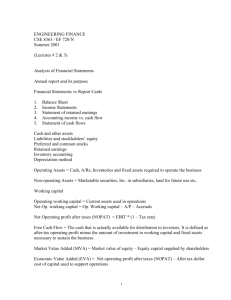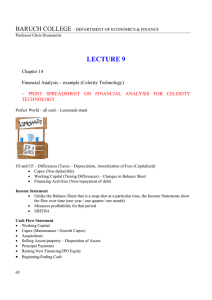Analysis & Interpretation of Financial Reports
advertisement

CA BUSINESS SCHOOL EXECUTIVE DIPLOMA IN BUSINESS AND ACCOUNTING SEMESTER 2: Interpretation of Financial Statements Analysis of Accounting Ratios M B G Wimalarathna (FCA, ACMA, ACIM, SAT, ACPM)(MBA–PIM/USJ) Ratio Analysis A popular tool used to conduct a quantitative analysis of information in a company's financial statements. Ratios are calculated from current year numbers and are then compared to previous years, other companies, the industry, or even the economy to judge the performance of the company. Key Categories of ratios are as follows; Profitability. Efficiency. From the View point of the Liquidity. Company/Key Management. Gearing/Capital Structure. Investors/Market Performance. (Investors’ point of view.) wimal 2 Profitability Ratios What does this measure & indicate to users/Stakeholders? Profitability ratios Primary Secondary Primary 1. ROE. (Return On Equity) What? How to calculate? 2. ROA. (Return On Assets) What? How to calculate? NP. atri. O/SHS. x100 Avg. Equity EBIT Avg. Assets x100 wimal 3 Secondary 1. GP Margin. (Gross Profit) ) What? How to calculate? 2. OP Margin. (Operating Profit) ) What? How to calculate? 3. NP Margin. (Net Profit) ) What? How to calculate? GP x100 Total Sales OP x100 Total Sales NP x100 Total Sales wimal 4 Efficiency Ratios What does this measure & indicate to users/Stakeholders? 1. Asset Turnover Ratio What? How to calculate? Total Sales Avg. total Assets (Times / x) 2. Inventory/Stock Turnover Ratio What? How to calculate? Cost of Sales Avg. Stock 3. Debtors Turnover Ratio What? How to calculate? Total Credit Sales Avg. Drs. wimal 5 4. Stock Residency Period - Direct/Indirect Avg. Stock x 365/50/12 What? Cost of Sales How to calculate? 5. Debtors Collection Period - Direct/Indirect Avg.Debtors x365/50/12 What? Total Credit Sales How to calculate? 6. Activity Cycle SRP + DCP What? How to calculate? • If Figures are not available, how to calculate? wimal 6 Liquidity Ratios What does this measure & indicate to users / stakeholders? 1. Current Ratio. CA CL What is best for the company??? What? How to calculate? 2. Quick Asset/Acid Test Ratio. (CA - St.) CL Traditional. Is this correct? What? How to calculate? 3. Cash Flow Ratio. NCF. OP. act CL What? How to calculate? wimal 7 Gearing/Capital Structure Ratios What does this measure & indicate to users / stakeholders? 1. Debt to equity Ratio/Gearing. Total Liabilities x 100 What? Total Equity How to calculate? Is high or low, good? 2. Debt Ratio. Total Liabilities x 100 Total Assets What? How to calculate? wimal 8 3. Equity Ratio. Total Equity x 100 Total Assets What? How to calculate? 4. Interest Coverage Ratio. EBIT F/Cost Sometimes, efficiency. What? How to calculate? 5. Debt Coverage Ratio. NCL NCF.op.act What? How to calculate? wimal 9 Investors'/Market Performance Ratios What does this measure & indicate to users / stakeholders? 1. Net Tangible asset backing per share (OS/HE-IA) O/SC What? How to calculate? 2. EPS NP. atri.OSHs WA. O/Sc What? How to calculate? 3. Operating cash flow per share (NCF. op. - Pr. Divi) WA. O/Sc What? How to calculate? wimal 1 4. Dividend per share Divi. paid + proposed WA. O/Sc What? How to calculate? 5. PE Ratio MPS EPS What? How to calculate? wimal 1 1 DuPont analysis A method of performance measurement that was started by the DuPont Corporation in the 1920s. With this method, assets are measured at their gross book value rather than at net book value in order to produce a higher return on equity (ROE). It is also known as "DuPont identity". DuPont analysis tells us that ROE is affected by three things: - Operating efficiency, which is measured by profit margin - Asset use efficiency, which is measured by total asset turnover - Financial leverage, which is measured by the equity multiplier ROE = Profit Margin (Profit/Sales) * Total Asset Turnover (Sales/Assets) * Equity Multiplier (Assets/Equity) Ratio Analysis Vs Other Techniques Why Ratio Analysis become more popular than other techniques? Is Ratio Analysis best for AFI? Shortcomings of ratio analysis. wimal 1






